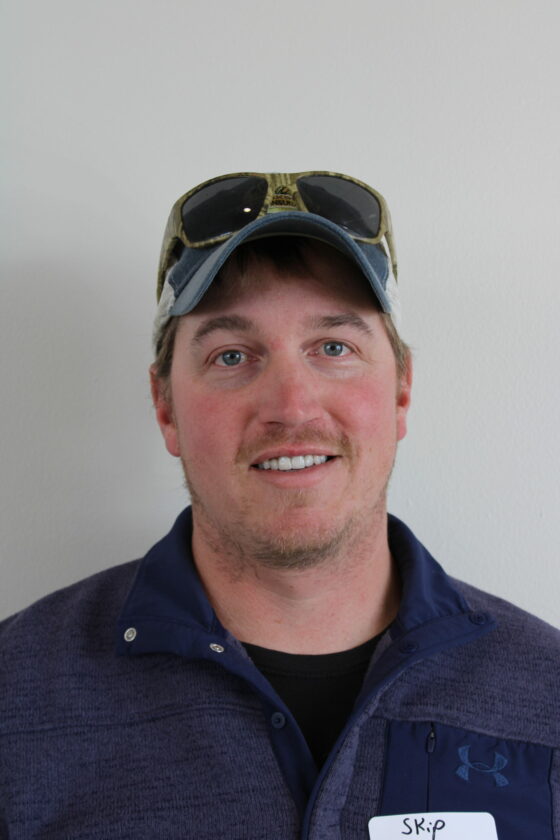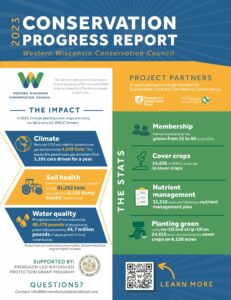Skip Grosskreutz is continuing to experiment with new sustainable farming practices and motivated by the betterment he sees for the entire community.

Grosskreutz is an agribusiness and farm insurance specialist at his family’s business, Grosskreutz Crop Insurance, in Clear Lake; he’s also been a crop farmer for about 17 years now. Growing up on a 50-cow dairy farm, his passion for agriculture has been ingrained in him since birth.
Sustainable farming practices, such as cover cropping and no-till usage, are prevalent on Grosskreutz’s farm today, but that wasn’t always the case.
“We used to till the ground like everyone did in the past,” he said. “I started doing research and testing out no-till. We implemented cover cropping about 10 years ago now and have seen the benefits of less soil erosion, less run-off and all the good things that go along with it.”
The main benefit Grosskreutz noticed because of cover cropping was the increase in organic matter.
“We take soil samples every three years, and our organic matter has continued to increase for as long as
we’ve been doing this,” he said.
Transitioning to cover cropping takes time and certainly doesn’t happen all at once.
“Originally, we just tried cover crops on a small portion of our acres, and then eventually we did it on
half of them. Now we’re doing it on all our acres,” Grosskreutz said. “Another thing we’re trying is
putting rye on some of our acres, taking it off in July or early August, having more of a long season cover
crop. It’s neat to see how the ground responds to this.”
Grosskreutz joined the Western Wisconsin Conservation Council a year ago thanks to the
encouragement of a fellow farmer. He enjoys collaborating with others in the group as well as
participating in the group’s events.
“I’ve learned a lot through our field events and meetings,” he said. “It’s interesting to learn what other
people are doing and what their goals are.”
Annual survey results
Grosskreutz is motivated by the group’s 2023 Member Conservation Practice Survey results to continue
learning and improving for the benefit of the whole community.
The group, composed of 60 farmers, implemented various conservation practices: planting 14,636 acres
of cover crops, using no-till and strip-till on 24,618 acres and planting into cover crops (otherwise known
as “planting green”) on 6,128 acres. They also measured nutrient management impact on 32,318 acres.
The potential environmental benefits of these practices:
- Reduction of greenhouse gas emissions by 4,249 metric tons of carbon dioxide equivalents, which is equal to greenhouse gas emissions produced by 1,101 cars driven in a year.
- Prevention of sediment loss from farm fields of 81,262 tons, equivalent to 8,126 dump trucks’ worth of soil.
- Reduction of phosphorus runoff by 89,478 pounds, potentially preventing 44.7 million pounds of algae growth in local water bodies.
Data was analyzed and verified by Farmers for Sustainable Food and the Wisconsin Department of
Agriculture, Trade and Consumer Protection.
As one of the group’s close partners, The Nature Conservancy is proud to see the results of the hard
work members of this producer-led watershed group are putting toward conservation.
“A great example of the group’s commitment to conservation is a year-over-year steady increase in farm
acres under improved nutrient management practices such as the adoption of variable rate technology
and split application of fertilizers,” Ricardo Costa, TNC’s associate director of agriculture strategies in
Wisconsin, said. “These practices not only benefit the farm’s bottom line by decreasing costs associated with the application of fertilizers but also the environment by reducing the possibility of excess nutrients
getting to our lakes and streams.”
Grosskreutz has set impressive conservation goals for the group and for farming throughout the state.
“My goal as a WWCC member is to have cover crops planted on all the acres in Wisconsin,” Grosskreutz
said. “I know it’s an ambitious goal, but that’s what we’re striving for.”
By the numbers:
Number of acres covered by conservation practices among Western Wisconsin Conservation Council
members:
- 2018 ― 26,841
- 2019 ― 101,514
- 2020 ― 155,520
- 2021 ― 159,932
- 2022 ― 145,295
- 2023 ― 174,877
Potential impact of conservation practices:
- Phosphorus runoff reduction ― 89,478 pounds
- Sediment erosion reduction ― 81,262 tons
- Carbon dioxide emission reduction ― 4,249 metric tons


